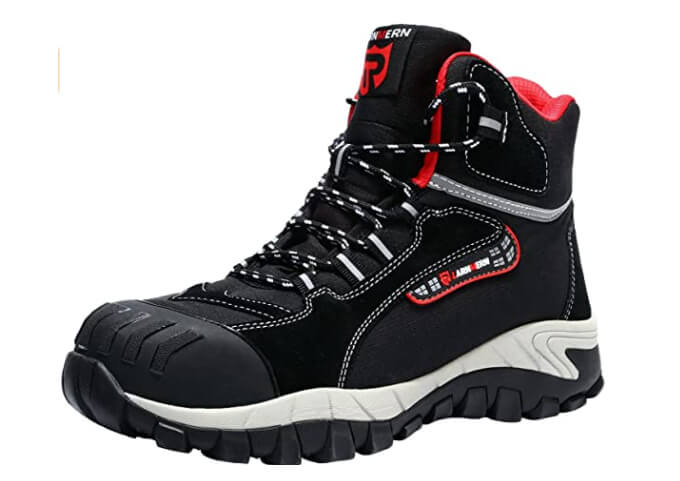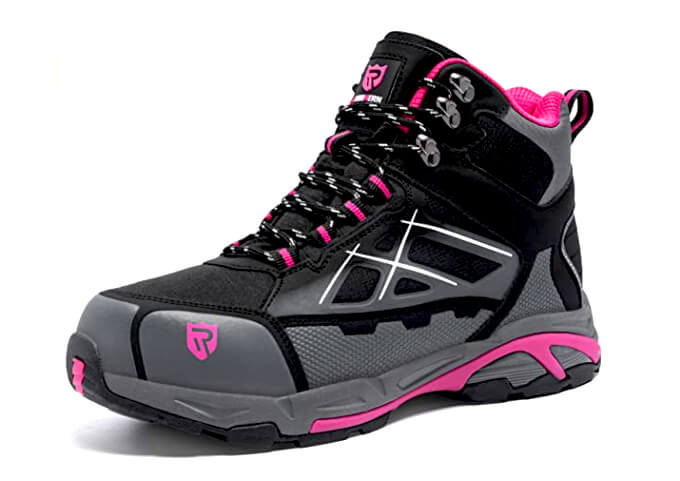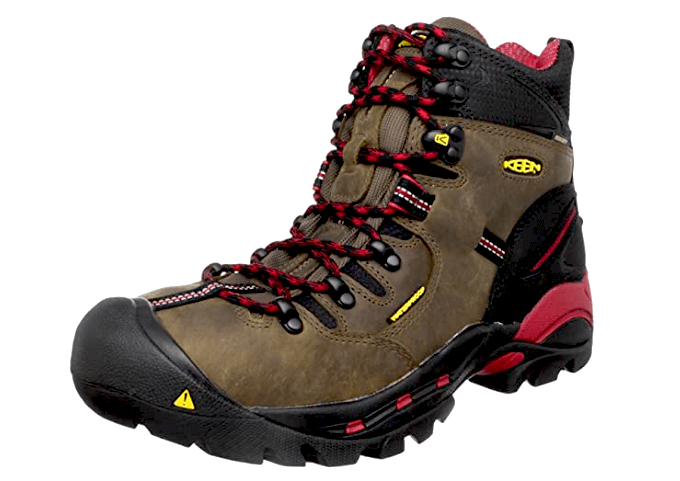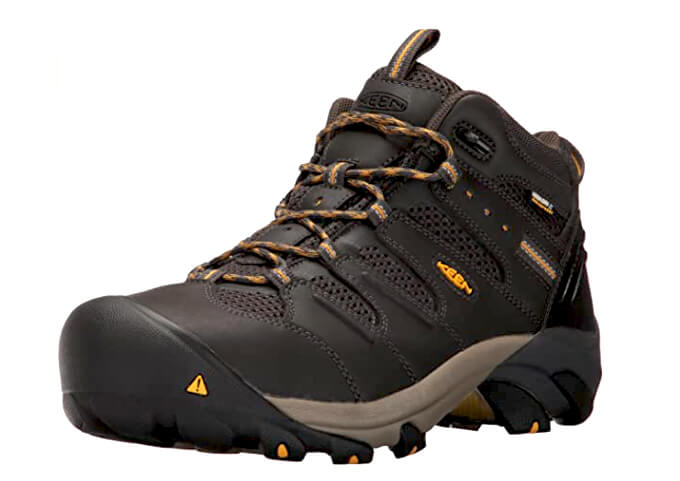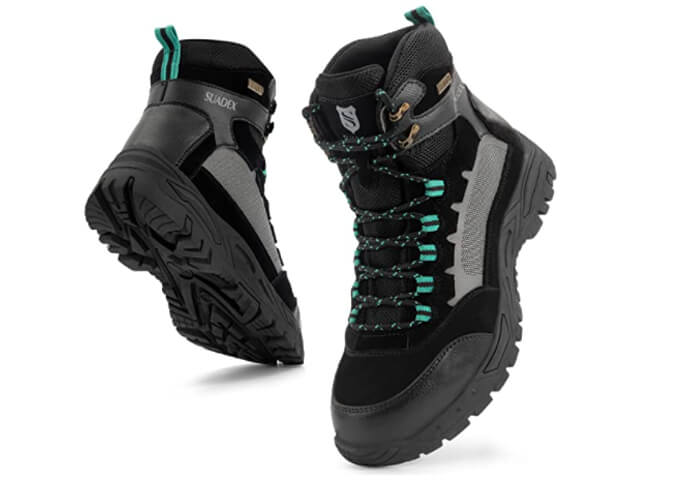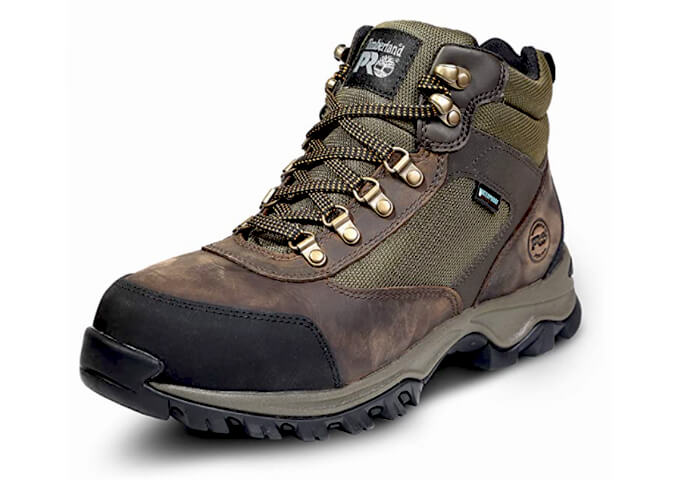You’ve probably heard of hiking boot brands such as Merrell, Teva, Keen, La Sportiva, and Timbaland, to name a few.
But did you know most of these hiking footwear companies also offer a Steel Cap hiking boot? So if you are a curious hiker like me, you are probably asking yourself, “can you hike in steel toe boots”?
The answer to this question is yes, you can hike in steel toe boots, and here are a few reasons why. First, steel toed boots are ideal for outdoor activities where you might encounter sharp objects.
They are durable and comfortable enough to wear during long hikes, although the biggest complaint against steel toed boots is their weight and length of time to break in.
To counter the benefits of a steel toe hiking boot, they are typically more expensive and uncomfortable, so it’s best to consider what kind of trail you will be hiking and the future utility of the boots.
This article will provide some helpful information about steel toe boots for hiking so you can decide if these are the proper hiking boots for you.
What’s the difference between traditional hiking boots versus steel-toed boots?
Have you ever worn running shoes on a trail run and experienced the instability or even felt stones through the rubber insoles? Hiking boots will provide the opposite feel of a running shoe on a hiking trail.
Hiking boots provide ample foot protection, grip, durability over a long trail walk on uneven ground. They are not made for fast, sharp turns and agility, but they are made to keep your feet and ankles safe.
But we’re not here to compare running shoes and hiking boots, so what are the differences between steel cap hiking boots and regular boots. The first difference is obviously the steel cap, and this article will cover what the steel cap does and why you would need it a little later on.
But weight will be strikingly different between regular composite toe boots and a steel toes boot. A traditional boot can weigh roughly 3 pounds or 1.3 kilograms. In contrast, a steel cap boot can weigh up to 5 pounds or 2.2 kilograms.
For reference, a Men’s Nike Pegasus running shoe weighs 0.6 pounds or 0.25 kilograms.
One should comfortably be able to cover a lot more ground in a traditional hiking boot than a steel cap boot just from the weight difference alone.
The steel cap boot will provide extra toe protection with some steel toe hiking boots even featuring reinforced steel soles.
Apart from that, both models of hiking boots will provide similar grip, high-end materials with the steel toe providing a tremendously more durability in the composite toe boots box.
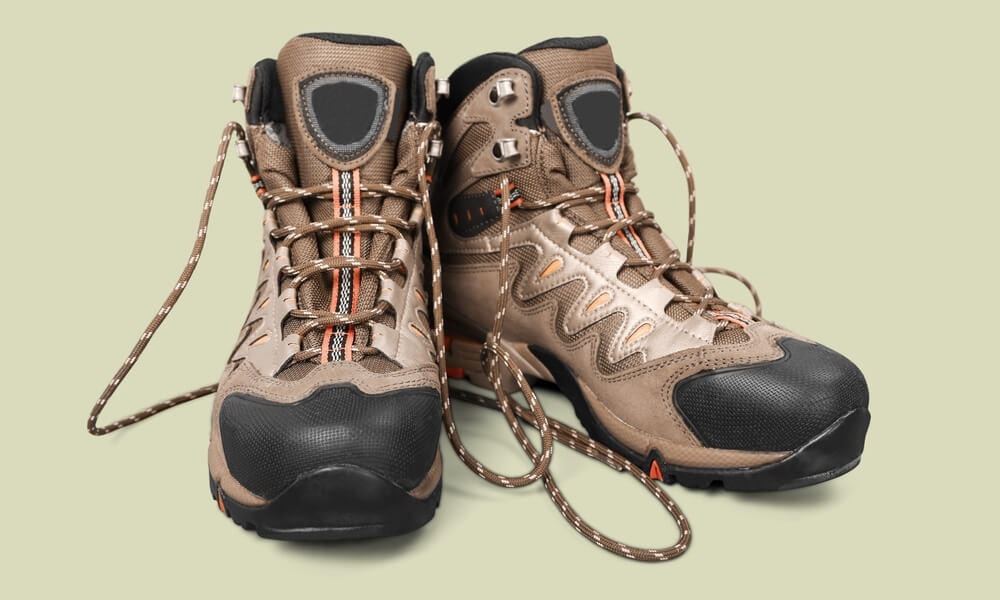
Can you wear regular steel cap work boots while hiking?
The short answer is yes, but with caveats. As previously mentioned, most hiking boot brands produce a steel cap hiking model. But if that’s not in your budget or timing, you can use a work boot as an alternative.
For years, I have used pull-on steel cap working boots in my factory job. I prefer them because they give me peace of mind that if something heavy were to fall on my toes, I would be protected.
Eventually, the pull-on style boots were prohibited at my workplace in favor of the lace-up style of boot. It didn’t matter if they were steel caps or not. All that mattered was that they had to be lace-ups.
The same goes when hiking in steel cap work boots.
Hiking boots should provide a standard level of stability and comfort, which pull-on style boots lack when compared to lace-ups.
The last thing you want is to be walking up or down rocky terrain, and one of your boots gets lodged and comes off completely. So if you have to wear steel cap work boots, make sure they are the lace-up version.
I have used lace-ups for hiking that felt like tanks, but they also felt exactly like a high-end hiking boot.
They also provided the same or similar grip, protection, and durability for hiking in all types of terrains and weather. So much so that I use steel toe work boots to this very day in my hiking footwear rotation.
What do steel cap boots exist
I can guarantee you that the first time anyone tries on a steel cap boot, whether it be for hiking or work, the next activity is to get a friend or a family member to step or jump on your toes as hard as possible.
Steel toed boots are synonymous for being used for work use on site in the construction industry, but they can be worn as part of a uniform in many industries and for various reasons.
A friend of mine who is a fishmonger wear work boots that are steel toe knee-length boots.
They provide her with excellent grip on the tiled, often wet working areas. While protecting her toes from the various work utensils use to cut up scores of seafood.
Steel toes as wear work boots are mandatory for most high-risk blue-collared occupations.
For hiking, they have manufactured steel cap boots to protect against rocky terrain, which may have a likelihood of having falling debris and craggy surfaces with potential to stub toes and risk injury.
Pros, Cons and other details of hiking with steel toe hiking boots
Pros
Stability: They provide excellent stability. In most cases, many hikers have said that they didn’t feel any earth or stones underneath their feet.
Protection: You’re going to be protected from any heavy objects that could land on the front portion of your foot. A steel toed boot will withstand 200 Joules or 150 pounds of foot force.
Similarly: Steel toes provide a similar profile to regular hiking shoes, and from the outside, most won’t even notice. Steel caps models are produced in the standard low, mid, and high boot profiles.
Durability: Steel cap hiking boots will provide the same level of durability as regular hiking boots with composite toes would. They will offer more longevity in the toe area.
Cons
Expensive: Unlike composite toe boots, most steel toes are going to have a higher premium because of the perceived extra protection features
Extra weight: The steel cap boot will weigh up to a kilo more than a non metallic safety toe. Think of every step you take your adding an extra kilo of exertion.
Discomfort: Steel caps are going to be less comfortable than regular hiking boots. Some have complained that they have felt the steel toes digging into their metatarsals during long hikes that require a lot of ascending or descending. Steel toe hiking boots are mainly used on short to medium hikes.
Considerations when looking to wear steel cap boots when hiking
So hopefully, you have a good idea if you can wear steel toe boots for hiking, but there are other considerations you need to be aware of before you go out hiking with them.
When you shouldn’t wear steel cap protective boots when hiking
First, there are anatomical reasons you wouldn’t want to lug around steel toe hiking boots, and the most common cause is foot health.
What is your current fitness level? Do you have any existing injuries not only to your feet but your ankles, calves up to your hips?
When was the time you saw your podiatrist? What has your weight training or thru-hike routine been like? When was the last time you went for a physically challenging hike?
Are you familiar with your intended steel cap boots, and have you broken them in?
These are just a few questions you should ask before hiking with steel caps. If you are unsure about any of these questions, take your time and research if this style of boot is the type for you.
Features and options on your steel cap boots
You must try on your steel cap hiking boots prior to attempting a hike if you’re going to go down the steel toe boot path. This also goes with any hiking boot, try them on first and get to know if there are any pain points.
If you intend to use your work boots on a hike, make sure you go on a couple of short walks before tackling the longer hikes.
It is easy to look at all the fantastic models of hiking boots on Amazon, but it’s no good to you if you haven’t tried them on.
Unlike regular office shoes that you can get away with trying on without damaging them with hiking boots, you’re going to want to try them in the environment.
Most return policies won’t cover your purchase if you have scuffed and dirtied the hiking boots.
For features, you will want to consider features such as waterproofing, breathability, good ankle support and toe support, profile, and extras such as reinforced laces, pull tabs, padding and grip.
Try lots of boots in store and choose the best one that suits your body type.
Weather will affect how your feet feel.
Going back to the running shoe example, if you have watched a running shoe review, many experienced runners give extra points to shoes with adequate and intuitive breathability and airflow features.
Unfortunately steel cap hiking boots are’nt know for excellent airflow and breathability, especially in the forefoot areas. So if it’s a hot and muggy day and your feet blister up quickly, reconsider steel cap boots.
In contrast, if it’s a sub-zero degree day, a steel cap boot can transfer cold temperatures directly onto the skin. This limits the scenarios you can use steel toe boots as they wont be comfortable in extreme conditions.
Will it be raining? If so, then that 3-kilogram steel toe boot might take on an extra kilo or two. An excellent waterproof boot cover will effectively keep water from weighing down your boots.
Fortunately, a solid boot liner can work wonders to provide both comfort and relief to hot and cold conditions and is essential for avoiding blisters and other foot-related injuries.
We have an article covering the best hiking boot liners here.
How many days and how long will your trail hike be
As previously mentioned in the pros and cons section, steel toe boots, over time, are going to fatigue your lower body faster than a regular hiking boot because of the added weight.
From my experience, you should be okay with using steel caps if your hike will be 2-3 hours.
It’s only after 4 hours of serious hiking that fatigue sets in. Remember your add an extra kilo per foot, per step, if you were hiking with steel caps.
You will use more energy, and you will need to account for your calories and hydration all from using heavier boots, which is why I always break in any hiking boot, steel caps or not, before I decide to take a longer walk head-on.
Trail conditions, and how to hike safely with steel toe boots
Steel cap boots excel in rocky, dry conditions and on a relatively flat and open surface. This environment might sound like a dream hiking trail, but that’s what you should look for to test your steel toe boots.
Trails with lots of moisture, rain, and mud aren’t ideal because steel caps absorb weight to add to their already cumbersome profile. But on a positive note, all the steel caps I have mentioned provide excellent grip and traction for wet weather.
As mentioned earlier, I enjoy rocky trails when using steel toe boots. It is a quirky experience because they are so rigid you can balance on a rock ledge with just your toes, and it will feel like you are standing on a balance beam.
This is because of the steel plate design into the sole in some models of hiking boots.
There is no more satisfying experience than accidentally kicking a hard shale or rock surface and not even flinching.
So make sure you consider the trail conditions if you’re deciding on using steel toes. If you have the room, you could always take a pair of trail runners to break up the fatigue if your feet get tired.
Conclusion
Keep reading as I provide a few of the best steel toe boots for hiking that can be found on Amazon right now.
So, in summary, steel toe boots for hiking can be great in the right conditions, just be sure that your are physically fit for the additional weight. That you are familiar with steel toe boots features, the model and fit.
And that you have planned an ideal trail and prepared for the weather conditions.
When using steel cap boots, stick to shorter hikes, focus on your breathing and go slow. If you start to feel pain, stop immediately and swap out your shoes if you have brought trail runners.
Try to reduce additional weight by auditing your backpack and equipment, or you can use hiking poles to help support your upper body and relieve your lower body.
What we recommend
Mens Steel Toe Boots For Outdoor Protection
LARNMERN
Product Summary
These steel toed boots go over and above in terms of safety features. Labelled as anti-smash & anti-punture for the construction site they can withstand 200 joules of force which is more than enough to protect your toes from sharp falling heavy objects.
Best Features
Women Indestructible Steel Toe Boots for Hiking
LARNMERN
Product Summary
These steel toed boots are great for hiking and job site environments. They feature high puncture resistance and a memory foam insole for added comfort. The outer rubber lugs provide solid grip traction while still feeling like an agile boot.
Best Features
Men’s Pittsburgh 6″ Steel Toe Waterproof Leather Boot
KEEN
Product Summary
Built like a tank the Pittsburgh is constructed with steel toes, stability plate and steel shank support. Great boots for rugged terrain or work boots and if you have a wider foot however you can replace the soles to get that perfect fit.
Best Features
Men’s Utility Lansing Mid Steel Toe Waterproof Leather Boot
KEEN
Product Summary
The Lansing mid steel toe hiking boots and work boots are built for comfort and agility. The steel toes have been constructed to form naturally around the forefoot and lightweight profile works well with its aggressive and improve traction design.
Best Features
Men Steel Toe Winter Hiking Boots Slip-Resistant & Waterproof
SUADEX
Product Summary
The Suadex Steel Toes meet the European standard of withstanding 200 joules of impact. The lace ups are intuitively constructed to provide comfort and a lock in feel. The outer is made from a puncture proof Kevlar material.
Best Features
Men’s Keele Ridge Steel Toe Waterproof Industrial Boot
Timberland
Product Summary
The Keel Ridge Steel Toe Boots from Timberland focus on lightweight protection. Featuring a high ankle support and nylon shank support with a solid steel cap as rigid as the profile sounds they excel in flexibility. A good option for most work boots and good for hiking.

